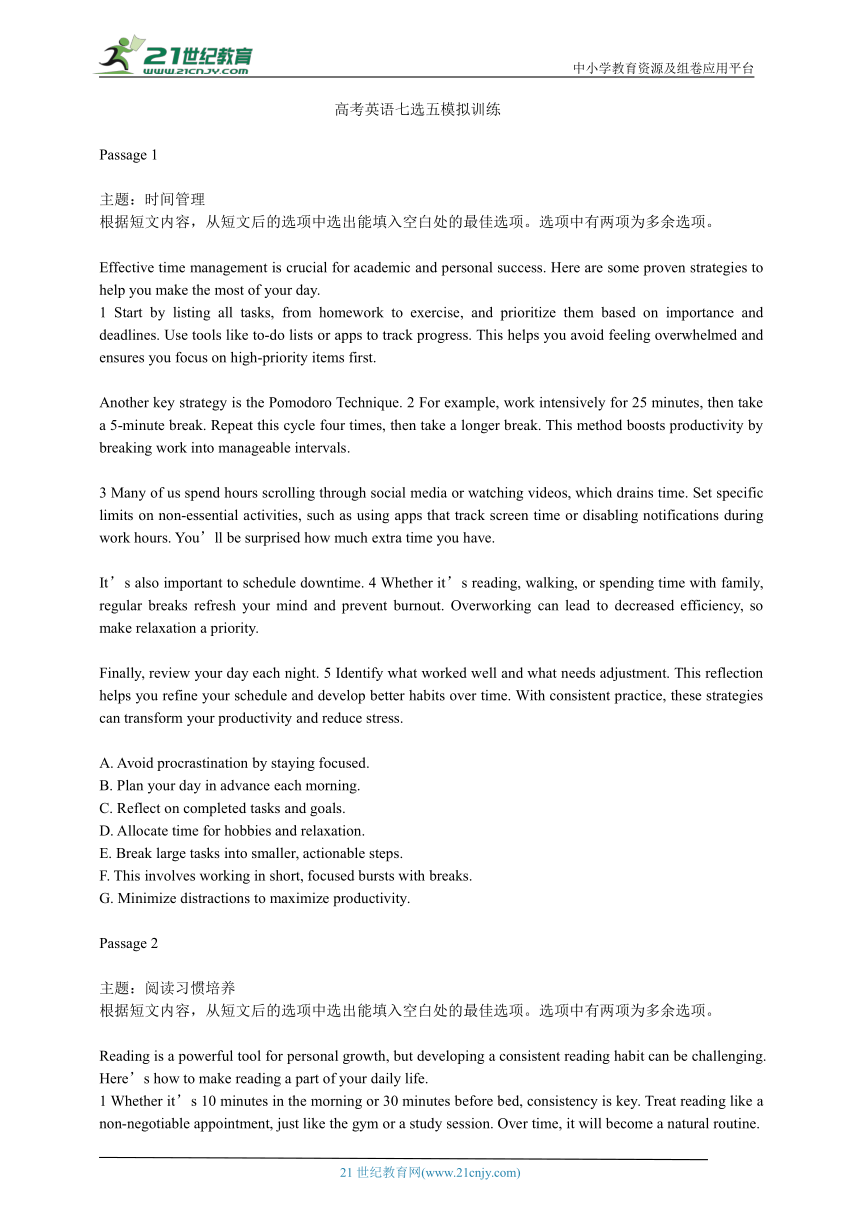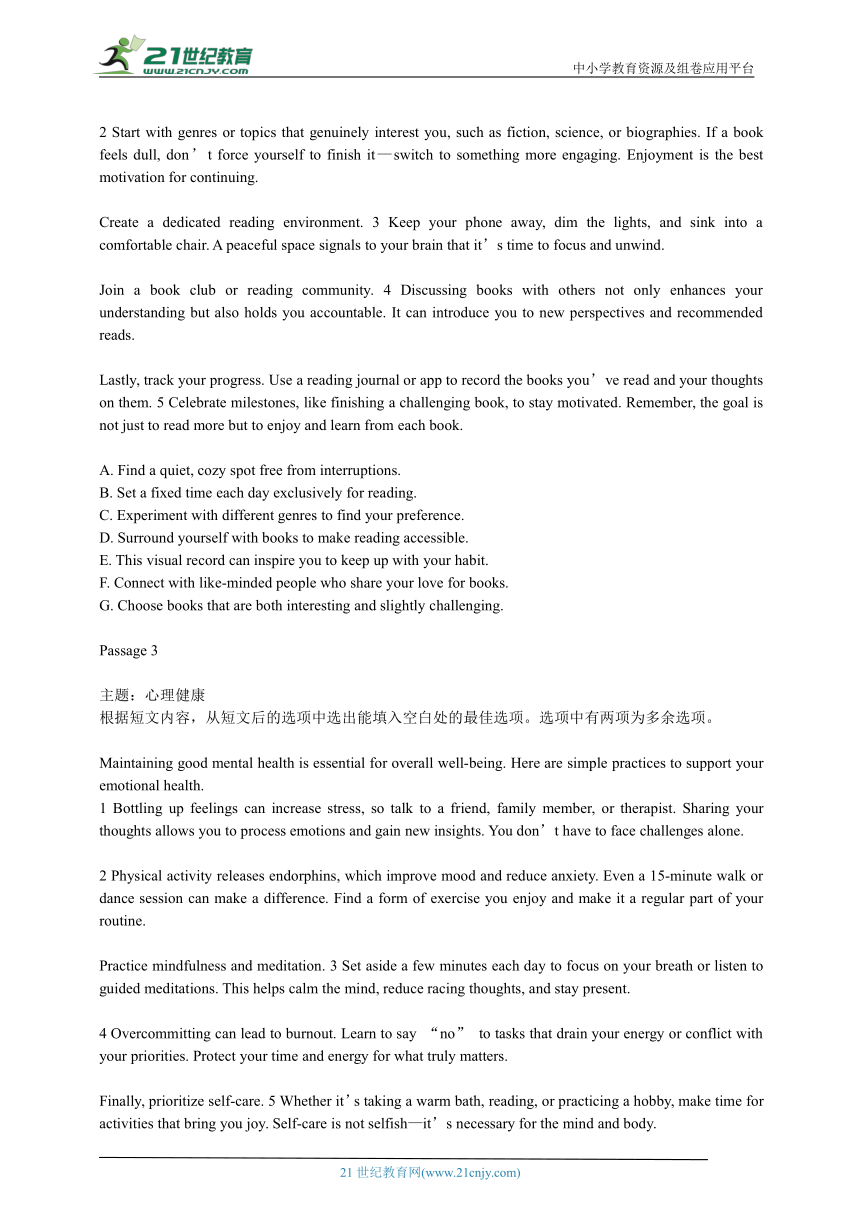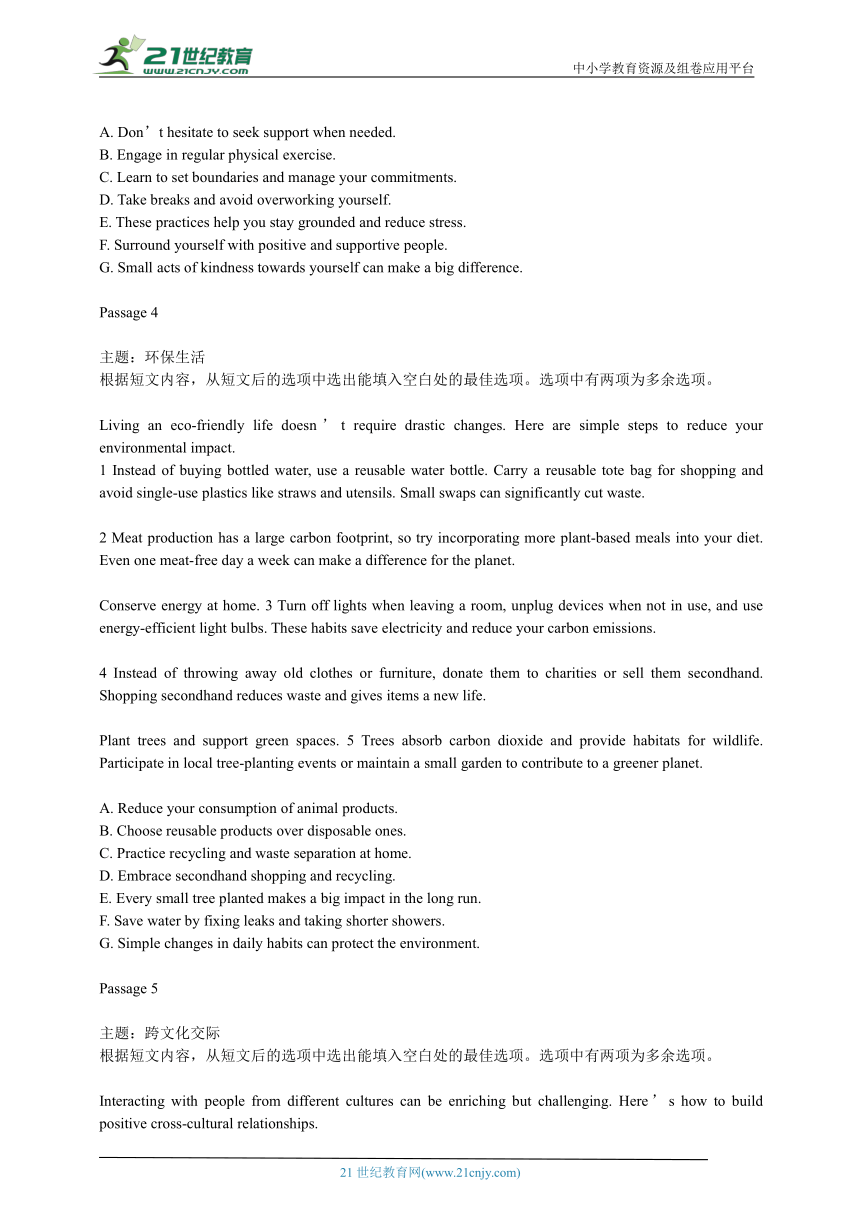2025 高考英语模拟训练 七选五(含答案)
文档属性
| 名称 | 2025 高考英语模拟训练 七选五(含答案) |  | |
| 格式 | doc | ||
| 文件大小 | 162.5KB | ||
| 资源类型 | 试卷 | ||
| 版本资源 | 通用版 | ||
| 科目 | 英语 | ||
| 更新时间 | 2025-04-30 00:43:05 | ||
图片预览



文档简介
中小学教育资源及组卷应用平台
高考英语七选五模拟训练
Passage 1
主题:时间管理
根据短文内容,从短文后的选项中选出能填入空白处的最佳选项。选项中有两项为多余选项。
Effective time management is crucial for academic and personal success. Here are some proven strategies to help you make the most of your day.
1 Start by listing all tasks, from homework to exercise, and prioritize them based on importance and deadlines. Use tools like to-do lists or apps to track progress. This helps you avoid feeling overwhelmed and ensures you focus on high-priority items first.
Another key strategy is the Pomodoro Technique. 2 For example, work intensively for 25 minutes, then take a 5-minute break. Repeat this cycle four times, then take a longer break. This method boosts productivity by breaking work into manageable intervals.
3 Many of us spend hours scrolling through social media or watching videos, which drains time. Set specific limits on non-essential activities, such as using apps that track screen time or disabling notifications during work hours. You’ll be surprised how much extra time you have.
It’s also important to schedule downtime. 4 Whether it’s reading, walking, or spending time with family, regular breaks refresh your mind and prevent burnout. Overworking can lead to decreased efficiency, so make relaxation a priority.
Finally, review your day each night. 5 Identify what worked well and what needs adjustment. This reflection helps you refine your schedule and develop better habits over time. With consistent practice, these strategies can transform your productivity and reduce stress.
A. Avoid procrastination by staying focused.
B. Plan your day in advance each morning.
C. Reflect on completed tasks and goals.
D. Allocate time for hobbies and relaxation.
E. Break large tasks into smaller, actionable steps.
F. This involves working in short, focused bursts with breaks.
G. Minimize distractions to maximize productivity.
Passage 2
主题:阅读习惯培养
根据短文内容,从短文后的选项中选出能填入空白处的最佳选项。选项中有两项为多余选项。
Reading is a powerful tool for personal growth, but developing a consistent reading habit can be challenging. Here’s how to make reading a part of your daily life.
1 Whether it’s 10 minutes in the morning or 30 minutes before bed, consistency is key. Treat reading like a non-negotiable appointment, just like the gym or a study session. Over time, it will become a natural routine.
2 Start with genres or topics that genuinely interest you, such as fiction, science, or biographies. If a book feels dull, don’t force yourself to finish it—switch to something more engaging. Enjoyment is the best motivation for continuing.
Create a dedicated reading environment. 3 Keep your phone away, dim the lights, and sink into a comfortable chair. A peaceful space signals to your brain that it’s time to focus and unwind.
Join a book club or reading community. 4 Discussing books with others not only enhances your understanding but also holds you accountable. It can introduce you to new perspectives and recommended reads.
Lastly, track your progress. Use a reading journal or app to record the books you’ve read and your thoughts on them. 5 Celebrate milestones, like finishing a challenging book, to stay motivated. Remember, the goal is not just to read more but to enjoy and learn from each book.
A. Find a quiet, cozy spot free from interruptions.
B. Set a fixed time each day exclusively for reading.
C. Experiment with different genres to find your preference.
D. Surround yourself with books to make reading accessible.
E. This visual record can inspire you to keep up with your habit.
F. Connect with like-minded people who share your love for books.
G. Choose books that are both interesting and slightly challenging.
Passage 3
主题:心理健康
根据短文内容,从短文后的选项中选出能填入空白处的最佳选项。选项中有两项为多余选项。
Maintaining good mental health is essential for overall well-being. Here are simple practices to support your emotional health.
1 Bottling up feelings can increase stress, so talk to a friend, family member, or therapist. Sharing your thoughts allows you to process emotions and gain new insights. You don’t have to face challenges alone.
2 Physical activity releases endorphins, which improve mood and reduce anxiety. Even a 15-minute walk or dance session can make a difference. Find a form of exercise you enjoy and make it a regular part of your routine.
Practice mindfulness and meditation. 3 Set aside a few minutes each day to focus on your breath or listen to guided meditations. This helps calm the mind, reduce racing thoughts, and stay present.
4 Overcommitting can lead to burnout. Learn to say “no” to tasks that drain your energy or conflict with your priorities. Protect your time and energy for what truly matters.
Finally, prioritize self-care. 5 Whether it’s taking a warm bath, reading, or practicing a hobby, make time for activities that bring you joy. Self-care is not selfish—it’s necessary for the mind and body.
A. Don’t hesitate to seek support when needed.
B. Engage in regular physical exercise.
C. Learn to set boundaries and manage your commitments.
D. Take breaks and avoid overworking yourself.
E. These practices help you stay grounded and reduce stress.
F. Surround yourself with positive and supportive people.
G. Small acts of kindness towards yourself can make a big difference.
Passage 4
主题:环保生活
根据短文内容,从短文后的选项中选出能填入空白处的最佳选项。选项中有两项为多余选项。
Living an eco-friendly life doesn’t require drastic changes. Here are simple steps to reduce your environmental impact.
1 Instead of buying bottled water, use a reusable water bottle. Carry a reusable tote bag for shopping and avoid single-use plastics like straws and utensils. Small swaps can significantly cut waste.
2 Meat production has a large carbon footprint, so try incorporating more plant-based meals into your diet. Even one meat-free day a week can make a difference for the planet.
Conserve energy at home. 3 Turn off lights when leaving a room, unplug devices when not in use, and use energy-efficient light bulbs. These habits save electricity and reduce your carbon emissions.
4 Instead of throwing away old clothes or furniture, donate them to charities or sell them secondhand. Shopping secondhand reduces waste and gives items a new life.
Plant trees and support green spaces. 5 Trees absorb carbon dioxide and provide habitats for wildlife. Participate in local tree-planting events or maintain a small garden to contribute to a greener planet.
A. Reduce your consumption of animal products.
B. Choose reusable products over disposable ones.
C. Practice recycling and waste separation at home.
D. Embrace secondhand shopping and recycling.
E. Every small tree planted makes a big impact in the long run.
F. Save water by fixing leaks and taking shorter showers.
G. Simple changes in daily habits can protect the environment.
Passage 5
主题:跨文化交际
根据短文内容,从短文后的选项中选出能填入空白处的最佳选项。选项中有两项为多余选项。
Interacting with people from different cultures can be enriching but challenging. Here’s how to build positive cross-cultural relationships.
1 Do some research on customs, traditions, and social norms before engaging with a new culture. For example, learn basic greetings, table manners, or gift-giving rules. This shows respect and helps avoid misunderstandings.
2 Keep an open mind and avoid making assumptions based on stereotypes. Every individual is unique, and cultural differences are not right or wrong—just different. Be curious and willing to learn from others.
3 Communication styles vary across cultures. Some cultures prefer direct communication, while others value indirectness. Pay attention to verbal and nonverbal cues, such as eye contact or personal space, to adapt your approach.
4 Sharing your own culture can foster mutual understanding. Cook a traditional dish, share stories, or teach a phrase in your language. This creates opportunities for connection and appreciation.
Finally, be patient and flexible. 5 Mistakes may happen, but they’re an opportunity to learn. Embrace the process of discovering new cultures, and remember that respect and kindness are universal.
A. Be aware of communication differences.
B. Respect cultural traditions and learn about them.
C. Focus on similarities rather than differences.
D. Avoid discussing sensitive topics like politics or religion.
E. Share your own cultural experiences and traditions.
F. Approach cultural differences with curiosity and openness.
G. Building cross-cultural relationships takes time and effort.
答案与解析
Passage 1 答案
1. B
2. F
3. G
4. D
5. C
解析:
1. B:段落讲列任务和优先级,“每天早上提前计划”符合首句总起作用。
2. F:前句提“番茄工作法”,F选项“短时间专注工作+休息”解释该方法。
3. G:后文讲限制社交媒体等干扰,G选项“减少干扰”总领段落。
4. D:段落讲安排休息时间,D选项“分配时间给爱好和放松”贴合主题。
5. C:前句提“每晚回顾一天”,C选项“反思完成的任务和目标”直接呼应。
Passage 2 答案
1. B
2. C
3. A
4. F
5. E
解析:
1. B:段落强调阅读时间的一致性,B选项“设定固定阅读时间”为段落核心。
2. C:后文讲选择感兴趣的体裁,C选项“尝试不同体裁”引出下文。
3. A:段落讲阅读环境,A选项“找安静舒适的地方”具体说明环境要求。
4. F:前句提“加入读书俱乐部”,F选项“与志同道合的人交流”承接上文。
5. E:前句讲“用日志记录阅读”,E选项“视觉记录激励习惯”解释其作用。
Passage 3 答案
1. A
2. B
3. E
4. C
5. G
解析:
1. A:段落讲分享感受,A选项“需要时寻求支持”为总起句。
2. B:后文讲运动释放内啡肽,B选项“定期锻炼”直接对应。
3. E:前句提“正念和冥想”,E选项“这些练习减轻压力”衔接自然。
4. C:后文讲学会拒绝,C选项“设定界限管理任务”总领段落。
5. G:段落讲自我关怀,G选项“小善举带来大不同”总结要点。
Passage 4 答案
1. B
2. A
3. G
4. D
5. E
解析:
1. B:段落讲替换一次性用品,B选项“选择可重复使用产品”为核心措施。
2. A:后文讲减少肉类消费,A选项“减少动物产品摄入”直接对应。
3. G:段落讲节能习惯,G选项“日常习惯保护地球”总结其意义。
4. D:后文讲捐赠和二手购物,D选项“拥抱二手购物和回收”总领段落。
5. E:前句讲种树,E选项“每棵小树长期影响大”强调其重要性。
Passage 5 答案
1. B
2. F
3. A
4. E
5. G
解析:
1. B:段落讲研究文化习俗,B选项“尊重并学习文化传统”为段落主旨。
2. F:后文讲开放心态,F选项“以好奇和开放态度对待文化差异”衔接下文。
3. A:段落讲沟通风格差异,A选项“注意沟通差异”总起该要点。
4. E:后文讲分享自身文化,E选项“分享文化经历和传统”直接对应。
5. G:前句讲耐心灵活,G选项“建立跨文化关系需时间和努力”总结段落。
解题技巧
1. 找关键词:注意空格前后的名词、动词或主题词,与选项中的同义词/短语匹配(如Passage 1“prioritize”与B选项“plan”)。
2. 分析逻辑关系:
总分结构:首句或段中为总起句(如Passage 2首段B选项)。
解释说明:后句解释前句概念(如Passage 1“Pomodoro Technique”对应F选项)。
因果/转折:通过逻辑连词(如but, so)判断选项(如Passage 3“Avoid overcommitting”对应C选项)。
3. 排除干扰项:多余选项常涉及未提及的细节(如Passage 4“water”与段落主题无关)或过度延伸。
4. 代入验证:完成后通读全文,确保逻辑连贯,如Passage 5“分享文化”与E选项“Share your own culture”紧密衔接。
通过以上练习,可有效提升七选五题型的解题速度和准确率!
21世纪教育网 www.21cnjy.com 精品试卷·第 2 页 (共 2 页)
HYPERLINK "http://21世纪教育网(www.21cnjy.com)
" 21世纪教育网(www.21cnjy.com)
高考英语七选五模拟训练
Passage 1
主题:时间管理
根据短文内容,从短文后的选项中选出能填入空白处的最佳选项。选项中有两项为多余选项。
Effective time management is crucial for academic and personal success. Here are some proven strategies to help you make the most of your day.
1 Start by listing all tasks, from homework to exercise, and prioritize them based on importance and deadlines. Use tools like to-do lists or apps to track progress. This helps you avoid feeling overwhelmed and ensures you focus on high-priority items first.
Another key strategy is the Pomodoro Technique. 2 For example, work intensively for 25 minutes, then take a 5-minute break. Repeat this cycle four times, then take a longer break. This method boosts productivity by breaking work into manageable intervals.
3 Many of us spend hours scrolling through social media or watching videos, which drains time. Set specific limits on non-essential activities, such as using apps that track screen time or disabling notifications during work hours. You’ll be surprised how much extra time you have.
It’s also important to schedule downtime. 4 Whether it’s reading, walking, or spending time with family, regular breaks refresh your mind and prevent burnout. Overworking can lead to decreased efficiency, so make relaxation a priority.
Finally, review your day each night. 5 Identify what worked well and what needs adjustment. This reflection helps you refine your schedule and develop better habits over time. With consistent practice, these strategies can transform your productivity and reduce stress.
A. Avoid procrastination by staying focused.
B. Plan your day in advance each morning.
C. Reflect on completed tasks and goals.
D. Allocate time for hobbies and relaxation.
E. Break large tasks into smaller, actionable steps.
F. This involves working in short, focused bursts with breaks.
G. Minimize distractions to maximize productivity.
Passage 2
主题:阅读习惯培养
根据短文内容,从短文后的选项中选出能填入空白处的最佳选项。选项中有两项为多余选项。
Reading is a powerful tool for personal growth, but developing a consistent reading habit can be challenging. Here’s how to make reading a part of your daily life.
1 Whether it’s 10 minutes in the morning or 30 minutes before bed, consistency is key. Treat reading like a non-negotiable appointment, just like the gym or a study session. Over time, it will become a natural routine.
2 Start with genres or topics that genuinely interest you, such as fiction, science, or biographies. If a book feels dull, don’t force yourself to finish it—switch to something more engaging. Enjoyment is the best motivation for continuing.
Create a dedicated reading environment. 3 Keep your phone away, dim the lights, and sink into a comfortable chair. A peaceful space signals to your brain that it’s time to focus and unwind.
Join a book club or reading community. 4 Discussing books with others not only enhances your understanding but also holds you accountable. It can introduce you to new perspectives and recommended reads.
Lastly, track your progress. Use a reading journal or app to record the books you’ve read and your thoughts on them. 5 Celebrate milestones, like finishing a challenging book, to stay motivated. Remember, the goal is not just to read more but to enjoy and learn from each book.
A. Find a quiet, cozy spot free from interruptions.
B. Set a fixed time each day exclusively for reading.
C. Experiment with different genres to find your preference.
D. Surround yourself with books to make reading accessible.
E. This visual record can inspire you to keep up with your habit.
F. Connect with like-minded people who share your love for books.
G. Choose books that are both interesting and slightly challenging.
Passage 3
主题:心理健康
根据短文内容,从短文后的选项中选出能填入空白处的最佳选项。选项中有两项为多余选项。
Maintaining good mental health is essential for overall well-being. Here are simple practices to support your emotional health.
1 Bottling up feelings can increase stress, so talk to a friend, family member, or therapist. Sharing your thoughts allows you to process emotions and gain new insights. You don’t have to face challenges alone.
2 Physical activity releases endorphins, which improve mood and reduce anxiety. Even a 15-minute walk or dance session can make a difference. Find a form of exercise you enjoy and make it a regular part of your routine.
Practice mindfulness and meditation. 3 Set aside a few minutes each day to focus on your breath or listen to guided meditations. This helps calm the mind, reduce racing thoughts, and stay present.
4 Overcommitting can lead to burnout. Learn to say “no” to tasks that drain your energy or conflict with your priorities. Protect your time and energy for what truly matters.
Finally, prioritize self-care. 5 Whether it’s taking a warm bath, reading, or practicing a hobby, make time for activities that bring you joy. Self-care is not selfish—it’s necessary for the mind and body.
A. Don’t hesitate to seek support when needed.
B. Engage in regular physical exercise.
C. Learn to set boundaries and manage your commitments.
D. Take breaks and avoid overworking yourself.
E. These practices help you stay grounded and reduce stress.
F. Surround yourself with positive and supportive people.
G. Small acts of kindness towards yourself can make a big difference.
Passage 4
主题:环保生活
根据短文内容,从短文后的选项中选出能填入空白处的最佳选项。选项中有两项为多余选项。
Living an eco-friendly life doesn’t require drastic changes. Here are simple steps to reduce your environmental impact.
1 Instead of buying bottled water, use a reusable water bottle. Carry a reusable tote bag for shopping and avoid single-use plastics like straws and utensils. Small swaps can significantly cut waste.
2 Meat production has a large carbon footprint, so try incorporating more plant-based meals into your diet. Even one meat-free day a week can make a difference for the planet.
Conserve energy at home. 3 Turn off lights when leaving a room, unplug devices when not in use, and use energy-efficient light bulbs. These habits save electricity and reduce your carbon emissions.
4 Instead of throwing away old clothes or furniture, donate them to charities or sell them secondhand. Shopping secondhand reduces waste and gives items a new life.
Plant trees and support green spaces. 5 Trees absorb carbon dioxide and provide habitats for wildlife. Participate in local tree-planting events or maintain a small garden to contribute to a greener planet.
A. Reduce your consumption of animal products.
B. Choose reusable products over disposable ones.
C. Practice recycling and waste separation at home.
D. Embrace secondhand shopping and recycling.
E. Every small tree planted makes a big impact in the long run.
F. Save water by fixing leaks and taking shorter showers.
G. Simple changes in daily habits can protect the environment.
Passage 5
主题:跨文化交际
根据短文内容,从短文后的选项中选出能填入空白处的最佳选项。选项中有两项为多余选项。
Interacting with people from different cultures can be enriching but challenging. Here’s how to build positive cross-cultural relationships.
1 Do some research on customs, traditions, and social norms before engaging with a new culture. For example, learn basic greetings, table manners, or gift-giving rules. This shows respect and helps avoid misunderstandings.
2 Keep an open mind and avoid making assumptions based on stereotypes. Every individual is unique, and cultural differences are not right or wrong—just different. Be curious and willing to learn from others.
3 Communication styles vary across cultures. Some cultures prefer direct communication, while others value indirectness. Pay attention to verbal and nonverbal cues, such as eye contact or personal space, to adapt your approach.
4 Sharing your own culture can foster mutual understanding. Cook a traditional dish, share stories, or teach a phrase in your language. This creates opportunities for connection and appreciation.
Finally, be patient and flexible. 5 Mistakes may happen, but they’re an opportunity to learn. Embrace the process of discovering new cultures, and remember that respect and kindness are universal.
A. Be aware of communication differences.
B. Respect cultural traditions and learn about them.
C. Focus on similarities rather than differences.
D. Avoid discussing sensitive topics like politics or religion.
E. Share your own cultural experiences and traditions.
F. Approach cultural differences with curiosity and openness.
G. Building cross-cultural relationships takes time and effort.
答案与解析
Passage 1 答案
1. B
2. F
3. G
4. D
5. C
解析:
1. B:段落讲列任务和优先级,“每天早上提前计划”符合首句总起作用。
2. F:前句提“番茄工作法”,F选项“短时间专注工作+休息”解释该方法。
3. G:后文讲限制社交媒体等干扰,G选项“减少干扰”总领段落。
4. D:段落讲安排休息时间,D选项“分配时间给爱好和放松”贴合主题。
5. C:前句提“每晚回顾一天”,C选项“反思完成的任务和目标”直接呼应。
Passage 2 答案
1. B
2. C
3. A
4. F
5. E
解析:
1. B:段落强调阅读时间的一致性,B选项“设定固定阅读时间”为段落核心。
2. C:后文讲选择感兴趣的体裁,C选项“尝试不同体裁”引出下文。
3. A:段落讲阅读环境,A选项“找安静舒适的地方”具体说明环境要求。
4. F:前句提“加入读书俱乐部”,F选项“与志同道合的人交流”承接上文。
5. E:前句讲“用日志记录阅读”,E选项“视觉记录激励习惯”解释其作用。
Passage 3 答案
1. A
2. B
3. E
4. C
5. G
解析:
1. A:段落讲分享感受,A选项“需要时寻求支持”为总起句。
2. B:后文讲运动释放内啡肽,B选项“定期锻炼”直接对应。
3. E:前句提“正念和冥想”,E选项“这些练习减轻压力”衔接自然。
4. C:后文讲学会拒绝,C选项“设定界限管理任务”总领段落。
5. G:段落讲自我关怀,G选项“小善举带来大不同”总结要点。
Passage 4 答案
1. B
2. A
3. G
4. D
5. E
解析:
1. B:段落讲替换一次性用品,B选项“选择可重复使用产品”为核心措施。
2. A:后文讲减少肉类消费,A选项“减少动物产品摄入”直接对应。
3. G:段落讲节能习惯,G选项“日常习惯保护地球”总结其意义。
4. D:后文讲捐赠和二手购物,D选项“拥抱二手购物和回收”总领段落。
5. E:前句讲种树,E选项“每棵小树长期影响大”强调其重要性。
Passage 5 答案
1. B
2. F
3. A
4. E
5. G
解析:
1. B:段落讲研究文化习俗,B选项“尊重并学习文化传统”为段落主旨。
2. F:后文讲开放心态,F选项“以好奇和开放态度对待文化差异”衔接下文。
3. A:段落讲沟通风格差异,A选项“注意沟通差异”总起该要点。
4. E:后文讲分享自身文化,E选项“分享文化经历和传统”直接对应。
5. G:前句讲耐心灵活,G选项“建立跨文化关系需时间和努力”总结段落。
解题技巧
1. 找关键词:注意空格前后的名词、动词或主题词,与选项中的同义词/短语匹配(如Passage 1“prioritize”与B选项“plan”)。
2. 分析逻辑关系:
总分结构:首句或段中为总起句(如Passage 2首段B选项)。
解释说明:后句解释前句概念(如Passage 1“Pomodoro Technique”对应F选项)。
因果/转折:通过逻辑连词(如but, so)判断选项(如Passage 3“Avoid overcommitting”对应C选项)。
3. 排除干扰项:多余选项常涉及未提及的细节(如Passage 4“water”与段落主题无关)或过度延伸。
4. 代入验证:完成后通读全文,确保逻辑连贯,如Passage 5“分享文化”与E选项“Share your own culture”紧密衔接。
通过以上练习,可有效提升七选五题型的解题速度和准确率!
21世纪教育网 www.21cnjy.com 精品试卷·第 2 页 (共 2 页)
HYPERLINK "http://21世纪教育网(www.21cnjy.com)
" 21世纪教育网(www.21cnjy.com)
